To start your tea tasting journey, opt for whole leaf teas and observe their appearance before brewing. Inhale the dry leaf aroma, then use proper water temperatures for each variety. Time your steeping carefully, and note the evolving flavors as you sip. Explore different tea types, from delicate whites to bold blacks. Cleanse your palate between tastings with water or mild crackers. Keep a journal to track your observations and preferences. Don't forget to slurp and aerate the tea to enhance flavor detection. With practice, you'll develop a refined palate and deeper appreciation for tea's nuanced characteristics. The world of tea awaits your exploration.
Start With Whole Leaf Teas
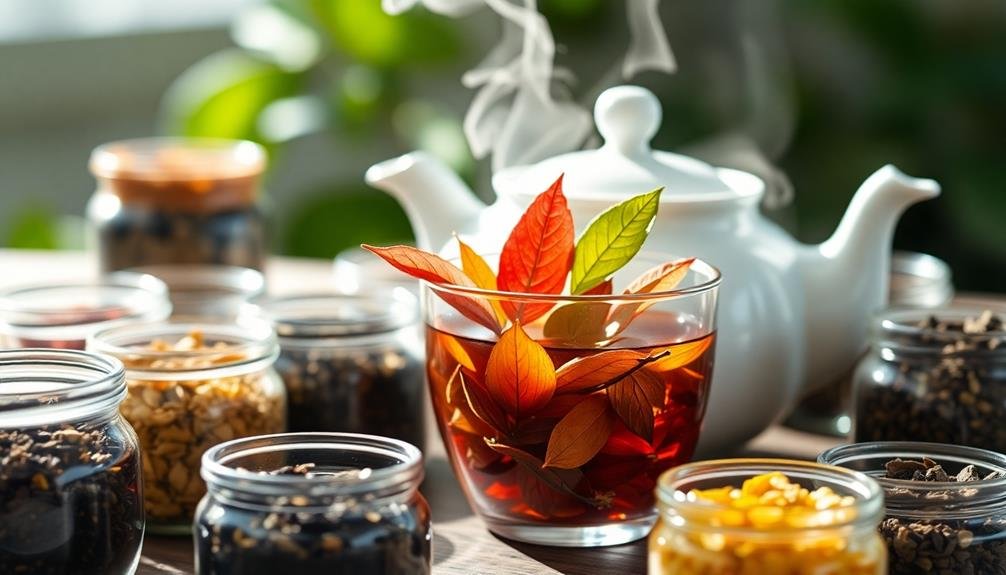
Most tea connoisseurs agree that whole leaf teas offer the best tasting experience. When you're starting your tea-tasting journey, opt for loose leaf teas instead of tea bags. Whole leaves retain more of their natural oils and flavors, resulting in a richer, more nuanced cup.
You'll find that whole leaf teas come in various grades and qualities. Look for teas with intact, full leaves rather than broken pieces or dust. These higher-quality leaves will unfurl during steeping, releasing complex flavors and aromas.
Begin with classic varieties like green, black, oolong, and white teas. Each type has distinct characteristics that you'll learn to identify. As you steep whole leaf teas, observe how the leaves expand and change color. This visual process is part of the tasting experience.
Use a clear glass teapot or infuser to watch the leaves steep. You'll notice subtle differences in leaf size, shape, and color between various teas. This observation will help you understand how these factors influence the final taste.
Observe the Dry Leaves
Before you steep your tea, take a moment to examine the dry leaves closely.
Look at the leaf shape and size, observing whether they're whole, broken, or tightly rolled.
Pay attention to the color and texture of the leaves, and don't forget to inhale their aroma, which can offer hints about the tea's flavor profile.
Leaf Shape and Size
The shape and size of tea leaves can reveal a lot about the tea's quality and processing method. When you're examining dry tea leaves, pay attention to their uniformity. High-quality teas often have leaves of consistent size and shape, indicating careful processing and sorting.
For whole leaf teas, look for intact leaves with minimal breakage. Larger leaves generally suggest a higher grade tea, while smaller pieces or dust are typically found in lower quality teas. The shape of the leaves can also indicate the tea type. For example, long, twisted leaves are common in oolong teas, while tightly rolled balls are characteristic of some green teas.
Notice any buds or tips present in the mix. Silver or golden tips in black teas often signify a premium grade. In green teas, the presence of downy buds is a sign of careful plucking and processing.
Some specialty teas have distinct leaf shapes. Gunpowder green tea, for instance, features tightly rolled pellets, while Dragon Well tea has flat, sword-like leaves.
Color and Texture
When examining dry tea leaves, three key aspects of color and texture demand your attention. First, observe the overall hue of the leaves, which can range from vibrant greens to deep blacks, with various shades in between.
Next, look for any variations or patterns in color across the leaves. Finally, assess the texture, noting whether the leaves appear smooth, rough, or somewhere in between.
Color and texture can provide valuable insights into the tea's quality, processing method, and potential flavor profile. Here's what to look for:
- Uniformity: High-quality teas often have consistent coloration across all leaves.
- Vibrancy: Bright, lively colors typically indicate freshness and proper storage.
- Sheen: A slight glossiness can suggest oils that contribute to the tea's aroma and flavor.
- Texture variations: Some teas may have a mix of fuzzy buds and smooth leaves, indicating careful plucking.
Remember that different tea types will have distinct color and texture characteristics. For example, green teas tend to be more vibrant, while oxidized teas like oolongs and blacks may have darker, more varied hues.
Aroma Before Brewing
Evaluating the aroma of dry tea leaves is an essential step in the tea tasting process. Before you brew your tea, take a moment to observe and smell the dry leaves. This will give you valuable insights into the tea's quality and character.
To begin, gently shake the container or bag to release the leaves' aroma. Bring the container close to your nose and take a deep inhale. Pay attention to the initial scent and any subtle notes that follow. Different teas have distinct aromas, which can hint at their flavor profiles:
| Tea Type | Typical Aromas |
|---|---|
| Green | Grassy, vegetal |
| Black | Malty, earthy |
| Oolong | Floral, fruity |
| White | Delicate, sweet |
As you smell the dry leaves, try to identify specific scents. Are they fresh and lively, or muted and stale? A strong, pleasant aroma often indicates high-quality tea, while a weak or off-putting smell may suggest the tea is old or improperly stored. Remember, the dry leaf aroma is just the beginning; it'll evolve once the tea is brewed, revealing its full complexity.
Smell the Tea Aroma
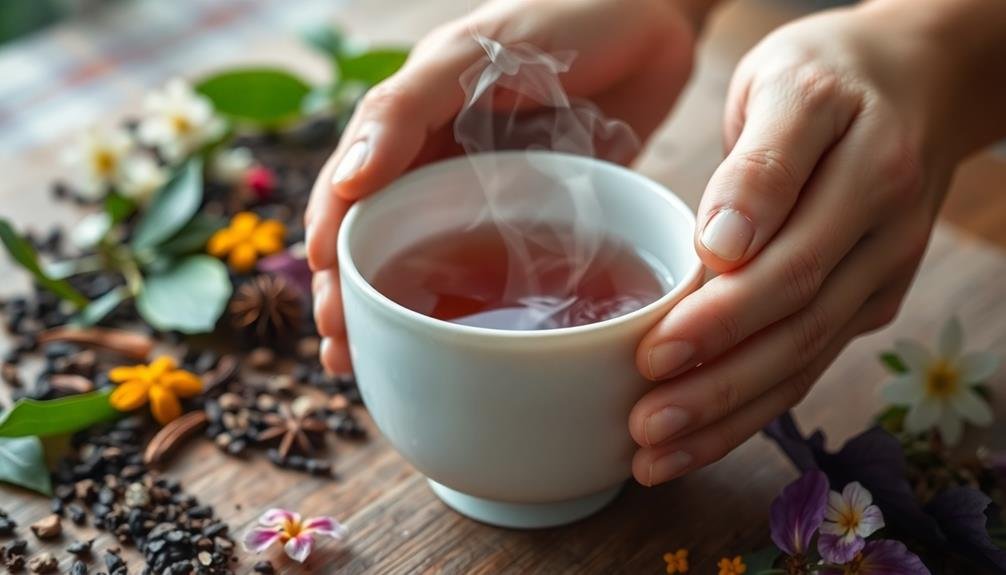
Aroma plays an essential role in tea appreciation. As you prepare to taste your tea, take a moment to inhale deeply and savor its scent. The aroma can reveal much about the tea's quality, origin, and processing methods.
It's also a great way to kickstart your sensory experience and prepare your palate for the flavors to come.
To fully appreciate the tea's aroma, follow these steps:
- Warm the cup or vessel with hot water before adding the dry leaves
- Place the dry leaves in the warmed vessel and inhale deeply
- After adding hot water, wait a few seconds and smell the wet leaves
- Finally, smell the brewed tea before taking your first sip
As you smell the tea, try to identify different notes. You might detect floral, fruity, earthy, or grassy scents.
Don't worry if you can't pinpoint specific aromas right away; with practice, you'll develop a more refined sense of smell. Remember that different teas have unique aromas, so exploring various types will help you build a mental library of scents.
Trust your nose and enjoy the aromatic journey that each cup of tea offers.
Use Proper Water Temperature
While aroma sets the stage for your tea experience, water temperature plays a starring role in extracting the perfect flavors from your leaves. Different tea types require specific water temperatures to bring out their best qualities.
For delicate green and white teas, use water between 160°F and 175°F to avoid bitterness. Oolong teas thrive in slightly hotter water, around 180°F to 190°F. Black teas and pu-erh can handle boiling water at 212°F, which helps release their robust flavors.
To achieve the right temperature, invest in a variable temperature kettle or use a thermometer. If you don't have these tools, you can estimate by letting boiling water cool for a few minutes before brewing lighter teas. For green tea, wait about two minutes; for oolong, one minute.
Remember that using water that's too hot can scald delicate leaves, resulting in a bitter brew. Conversely, water that's too cool won't extract enough flavor, leaving you with a weak cup.
Time Your Steeping Carefully
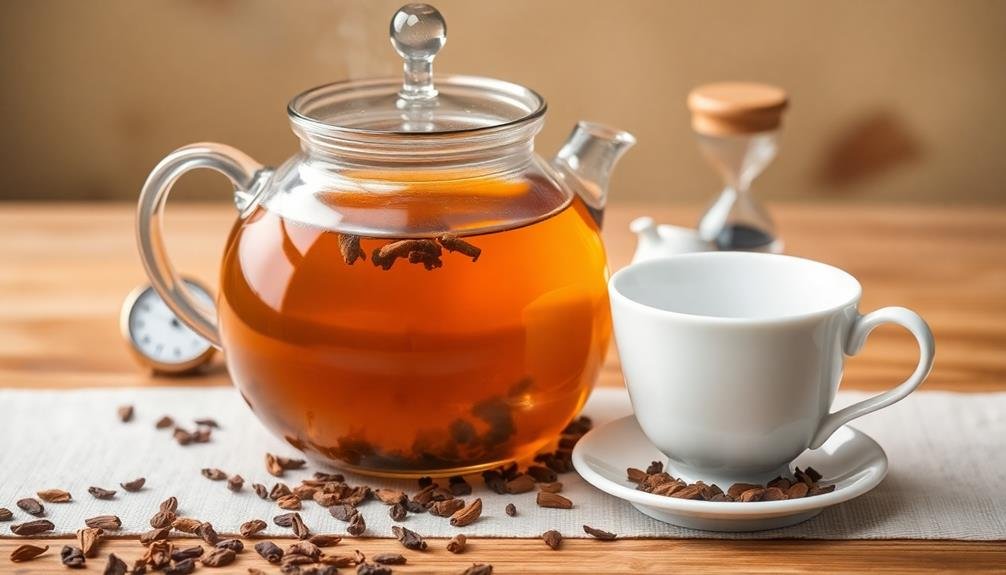
Precise timing is essential when steeping tea to achieve the perfect balance of flavors. Different types of tea require varying steeping times to extract their best taste and aroma. Over-steeping can lead to bitterness, while under-steeping may result in a weak, flavorless brew.
To guarantee you're getting the most out of your tea, follow these guidelines:
- Green tea: 1-3 minutes
- Black tea: 3-5 minutes
- Oolong tea: 2-5 minutes
- White tea: 1-3 minutes
Keep a timer handy and experiment within these ranges to find your preferred strength. Remember that factors like water temperature and leaf size can affect steeping time.
For loose leaf teas, use a tea infuser or strainer to easily remove the leaves when the time is up. If you're using tea bags, gently squeeze them against the side of your cup before discarding to release any remaining flavors.
Don't be afraid to adjust steeping times based on your personal taste preferences. With practice, you'll develop an intuitive sense of when your tea has reached its peak flavor profile.
Slurp and Aerate
To elevate your tea-tasting experience, try slurping your tea loudly as professional tasters do.
This technique aerates the tea, spreading it across your palate and enhancing your perception of its flavors.
You'll notice subtle notes and nuances that might otherwise go undetected, allowing for a more thorough appreciation of the tea's complexity.
Enhance Flavor Perception
Slurping and aerating your tea might seem impolite, but it's an essential technique for enhancing flavor perception. As you draw the tea into your mouth, the act of slurping introduces air, which helps to distribute the liquid across your palate and activate your taste buds. This process allows you to detect subtle flavor notes that might otherwise go unnoticed.
To further enhance your flavor perception, try these techniques:
- Hold the tea in your mouth for a few seconds before swallowing.
- Breathe out through your nose after swallowing to experience retronasal olfaction.
- Take small sips and focus on different parts of your tongue with each taste.
- Cleanse your palate between tastings with plain water or mild crackers.
Mimic Professional Tasters
Professional tea tasters employ three key techniques to fully experience a tea's flavor profile: slurping, aerating, and spitting.
To mimic their methods, start by slurping a small amount of tea into your mouth. This action spreads the liquid across your palate and tongue, allowing you to detect subtle flavors and nuances. As you slurp, slightly open your lips to draw in air, aerating the tea. This process enhances the tea's aromatics and helps you identify different taste components.
After savoring the tea for a few seconds, either swallow or discreetly spit it out. Spitting is common among professionals who taste numerous teas in one session, preventing caffeine overload and palate fatigue.
When you're ready to evaluate the next tea, rinse your mouth with water to cleanse your palate.
Practice these techniques with different teas to develop your tasting skills. Pay attention to the tea's body, astringency, and aftertaste.
With time, you'll be able to discern subtle differences between various tea types and origins. Remember, becoming a skilled tea taster takes patience and practice, so don't be discouraged if you can't immediately identify all the flavors.
Note Flavor Profiles
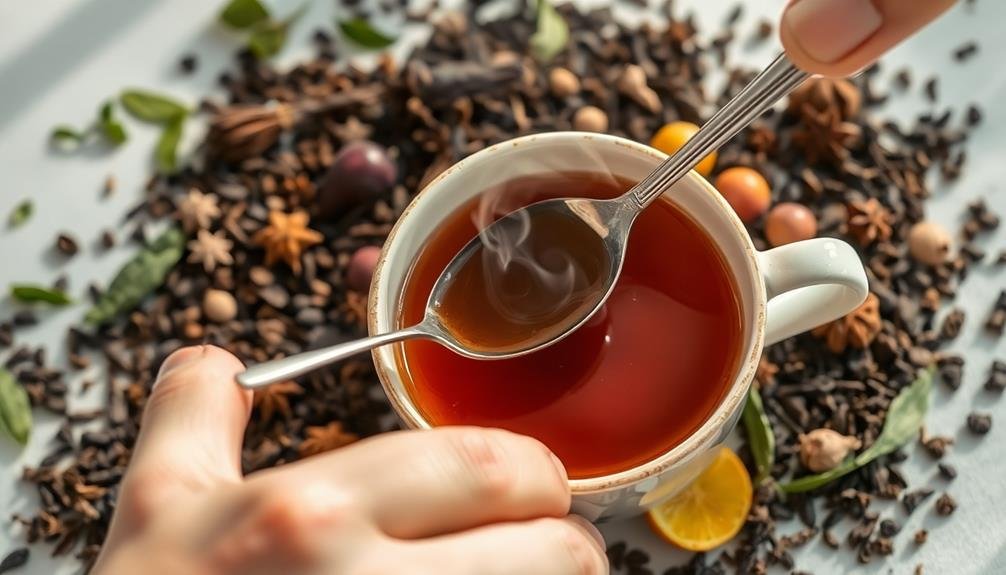
A tea's flavor profile is key to understanding and appreciating its unique characteristics. As you sip, focus on identifying the primary tastes: sweet, sour, bitter, salty, and umami. Pay attention to the tea's aroma, which can provide valuable clues about its flavor. Notice how the taste evolves from the first sip to the aftertaste, as some teas reveal different notes throughout the tasting experience.
To develop your palate and enhance your ability to note flavor profiles, try these techniques:
- Use a flavor wheel as a reference to help identify specific tastes and aromas.
- Compare different teas side by side to highlight their unique characteristics.
- Keep a tasting journal to track your observations and improve your descriptive skills.
- Experiment with brewing variables to understand how they affect flavor profiles.
Practice describing the tea's body, which refers to its weight and texture in your mouth. Is it light and crisp or full-bodied and creamy?
Look for any astringency, which can manifest as a drying sensation on your tongue. By consistently noting these aspects, you'll develop a more refined palate and a deeper appreciation for the nuances of various teas.
Explore Different Tea Varieties
To broaden your tea-tasting experience, try exploring various popular tea types like black, green, oolong, and white teas.
You'll find each category offers distinct flavors and aromas, from the bold and malty notes of English Breakfast to the delicate and grassy taste of Japanese Sencha.
Don't forget to sample regional tea specialties, such as Chinese Pu-erh or Indian Darjeeling, which showcase unique characteristics influenced by their local terroir and processing methods.
Popular Tea Types
Four main categories of tea dominate the global market: black, green, oolong, and white. Each type offers unique flavors, aromas, and health benefits.
Black tea, the most oxidized variety, provides a bold, full-bodied taste and is often enjoyed with milk and sugar. Green tea, minimally processed, retains its natural color and offers a fresh, grassy flavor. Oolong tea, partially oxidized, falls between black and green teas, delivering a complex taste profile. White tea, the least processed, boasts a delicate, subtle flavor.
To enhance your tea tasting experience, consider these popular varieties:
- Earl Grey (black tea with bergamot oil)
- Sencha (Japanese green tea)
- Ti Kuan Yin (Chinese oolong tea)
- Silver Needle (premium white tea)
As you explore these popular tea types, pay attention to their distinct characteristics. Notice the deep, malty notes in black teas, the vegetal undertones in green teas, the floral hints in oolongs, and the light, sweet nuances in white teas.
Don't hesitate to try different brewing methods and temperatures to reveal each tea's full potential.
Regional Tea Specialties
Tea's rich cultural heritage is reflected in the diverse regional specialties found across the globe. As you explore different tea varieties, you'll discover unique flavors and traditions tied to specific regions.
In China, you'll find Longjing (Dragon Well) green tea from Hangzhou, known for its flat leaves and chestnut-like taste. Oolong teas from Taiwan, such as Dong Ding, offer a complex flavor profile ranging from floral to roasted notes. Japan's matcha, a finely ground green tea, is central to the traditional tea ceremony and boasts a rich, umami flavor.
India's Darjeeling, often called the "Champagne of Teas," is prized for its muscatel flavor and floral aroma. Assam tea, grown in northeast India, is known for its robust, malty taste. In Sri Lanka, Ceylon teas vary in flavor depending on the elevation at which they're grown.
Morocco's mint tea, a blend of green tea and fresh mint leaves, is a symbol of hospitality. Russia's smoky Lapsang Souchong offers a bold, campfire-like taste.
Cleanse Your Palate

Cleansing your palate between teas is essential for an accurate tasting experience. It helps reset your taste buds, allowing you to fully appreciate the unique flavors and nuances of each tea you sample.
Without proper palate cleansing, the lingering flavors from previous teas can interfere with your perception of the current one, leading to a muddled and inaccurate tasting experience.
To effectively cleanse your palate, you've got several options at your disposal:
- Water: Sip room temperature water between teas to rinse your mouth and neutralize flavors.
- Plain crackers: Eat a small, unsalted cracker to absorb residual flavors and oils.
- Green apple slices: The crisp, tart flavor helps reset your taste buds quickly.
- Lemon sorbet: A small spoonful can refresh your palate and prepare it for the next tea.
Remember to take your time between tastings, allowing your palate to fully reset.
Don't rush through the process, as this can diminish your ability to discern subtle differences between teas.
Keep a Tea Tasting Journal
Precision is key when it comes to developing your tea tasting skills, and keeping a detailed journal is an invaluable tool in this pursuit. Start by selecting a notebook or digital app that you'll use consistently. For each tea you taste, record essential information like the tea's name, type, origin, and brewing parameters.
As you sip, jot down your sensory observations. Describe the tea's appearance, aroma, flavor profile, and mouthfeel. Be specific and use descriptive language. Don't hesitate to draw comparisons to familiar tastes or smells. Note any changes in flavor as the tea cools or with subsequent steepings.
Rate the tea's qualities on a scale, such as 1-10, for categories like aroma, taste, and overall enjoyment. This will help you track your preferences over time. Include personal notes about your mood, the occasion, or pairing suggestions.
Regularly review your journal entries to identify patterns in your taste preferences and to track your palate's development. You'll find that this practice not only enhances your tasting skills but also deepens your appreciation for the nuances of different teas.
Frequently Asked Questions
How Do I Choose the Right Teaware for Different Types of Tea?
You'll want to match your teaware to the tea type. For delicate green teas, use light porcelain. Choose clay pots for oolong and pu-erh. Glass is versatile for most teas. Consider brewing methods and serving sizes too.
Can I Reuse Tea Leaves for Multiple Infusions?
Yes, you can reuse tea leaves for multiple infusions. It's called "re-steeping" and it's common practice, especially for high-quality loose leaf teas. You'll notice subtle flavor changes with each infusion, enhancing your tea-tasting experience.
What's the Best Way to Store Tea to Maintain Its Flavor?
You'll want to store your tea in an airtight container away from light, heat, and moisture. Keep it in a cool, dark place like a pantry. Don't refrigerate it. Use within six months for ideal flavor.
How Does Altitude Affect the Taste of Tea?
You'll notice that higher altitude teas often have a more complex flavor. They're typically sweeter and more aromatic due to slower growth, which concentrates the leaves' compounds. Lower altitude teas tend to be bolder and more robust.
Are There Any Health Considerations When Tasting Different Teas Frequently?
You should be aware of caffeine content when tasting teas frequently. It's best to moderate your intake, especially if you're sensitive. Also, some teas may interact with medications, so consult your doctor if you have concerns.
In Summary
You've now got the essential tools to commence your tea-tasting journey. Remember, it's all about exploring and discovering what you enjoy. Don't be afraid to experiment with different varieties and brewing methods. Trust your senses and take notes as you go. With practice, you'll develop a refined palate and a deeper appreciation for the nuances of tea. So brew up a cup, and let your flavor adventure begin!


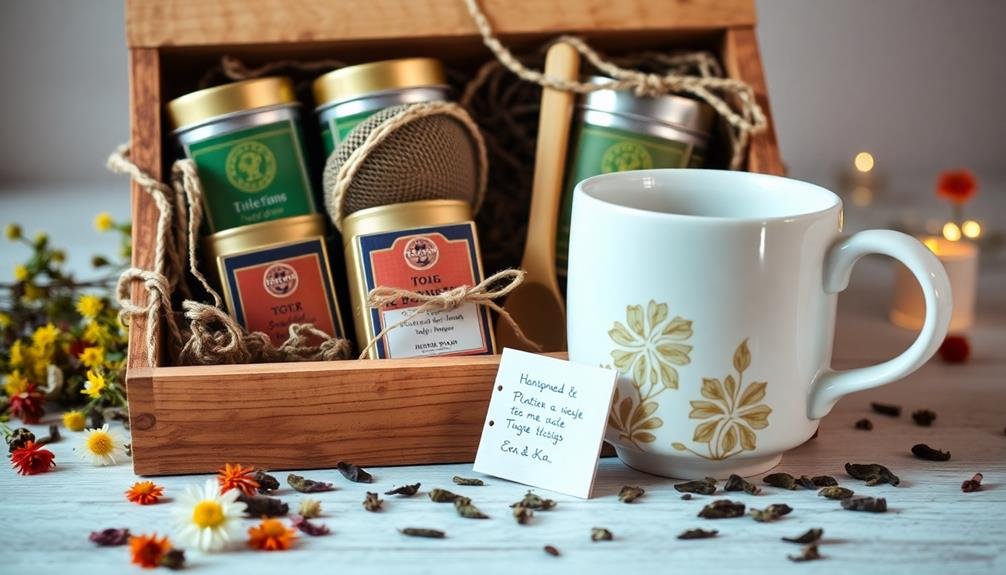
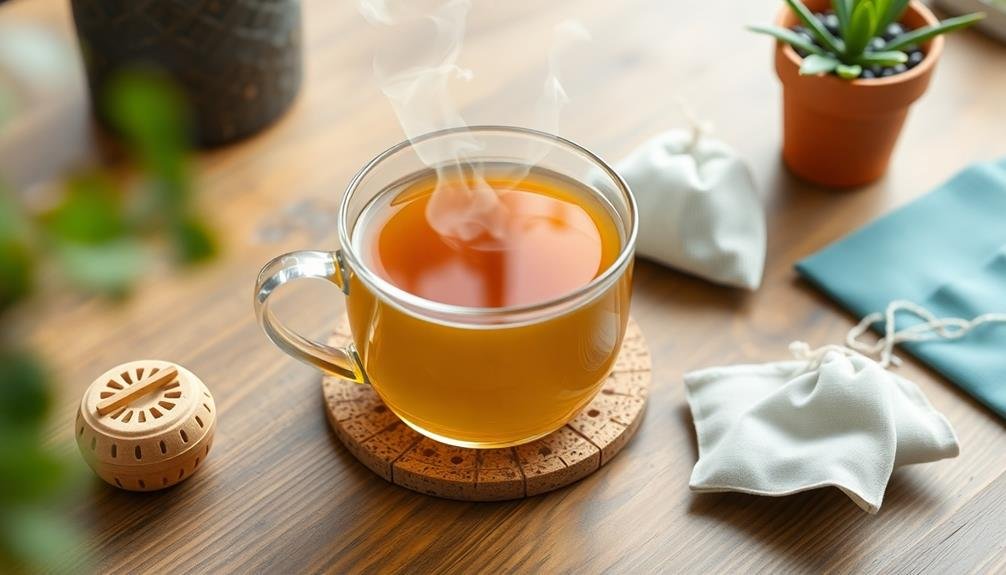
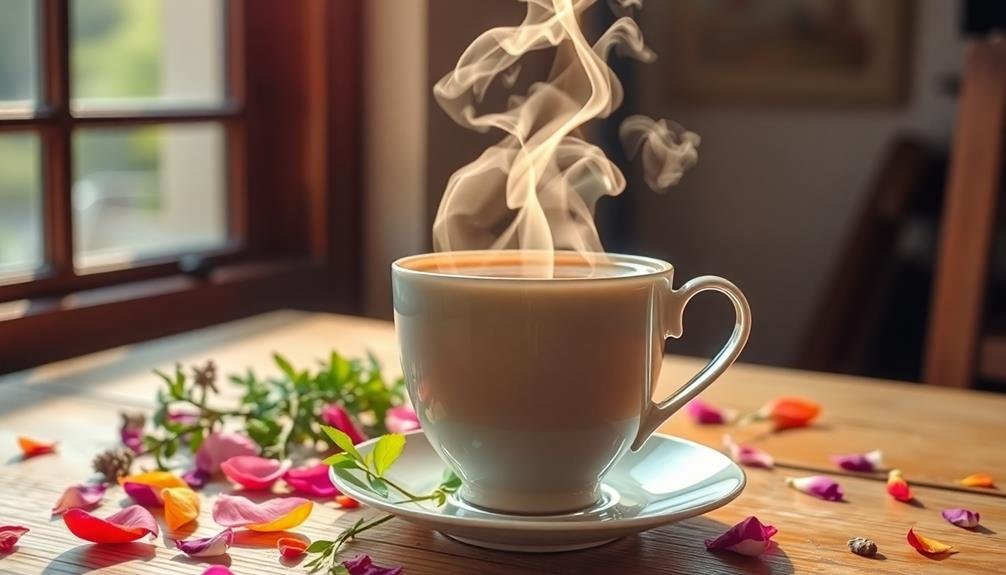
Leave a Reply